City of Arts and Sciences, Valencia: Where Art Meets Innovation
The City of Arts and Sciences in Valencia, known in Spanish as Ciudad de las Artes y las Ciencias. It is a captivating cultural and scientific hub, beautifully set within the former riverbed of the River Turia. Created by the famed Valencian architect Santiago Calatrava, this complex is an impressive display of architectural innovation. It holds a unique place among Europe’s most iconic attractions.
This impressive complex includes six elements. This consists of the Hemisfèric, an IMAX cinema with stunning digital projections, and the Umbracle, a scenic viewpoint. The Museu de les Ciències features interactive activities designed to spark curiosity in visitors of all ages. The Oceanogràfic is Europe’s largest aquarium, housing over 20,000 creatures from 650 species. The Palau de les Arts is a performance venue for opera, dance, and symphonic concerts. Lastly, the Àgora is as a multifunctional space for concerts and various activities.
Spanning two kilometers, the buildings are city icons and a must-visit spot for leisure and discovery. Make sure to plan your visit carefully so that you can experience all the amazing attractions available.
Key Attractions in the City of Arts and Sciences
Hemisfèric: The Eye of the City of Arts and Sciences
The Hemisfèric, designed by Santiago Calatrava, is one of the most striking buildings in the City of Arts and Sciences. Opening its doors in 1998, it stands as the complex’s centerpiece. The structure resembles a human eye which symbolizes wisdom, with a unique brise soleil roof and aluminum shutters that open like an eyelid. Covering 13,000 m² (139,931 sq ft), it sits next to a water pool. This creates the illusion of a complete eye, with the pool’s bottom made of glass.
Inside, the Hemisfèric offers an immersive experience with an IMAX theater, planetarium, and laserium, featuring 360-degree views during shows. The digital 3D cinema has a 900-meter concave screen that envelops spectators. It typically shows 45-minute films for all audiences which includes a daily children’s screening.
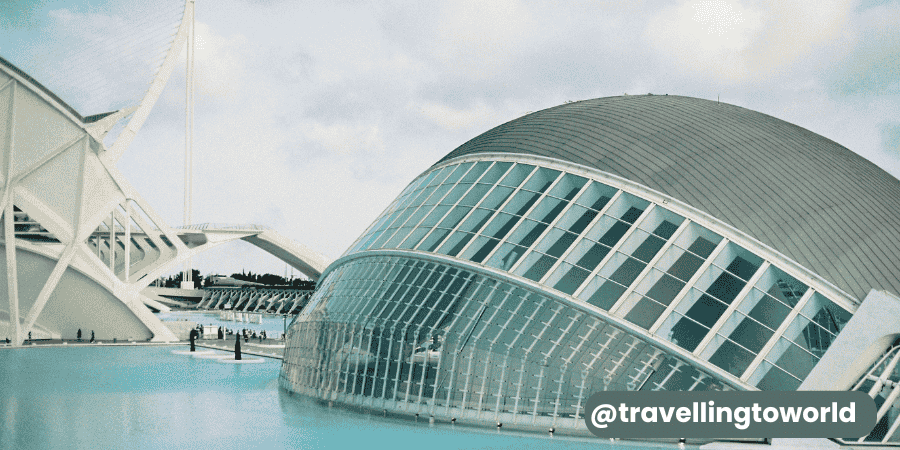
Tickets come with innovative 3D glasses that allow you to change the screening language, ensuring a personalized visit. Before you explore other buildings in the City of Arts and Sciences, you can check the film listings and reserve your preferred shows in advance.
Science Museum: Discover Innovation in the City of Arts and Sciences
The Museu de les Ciències Príncipe Felipe opened in 2000, is a fascinating destination for science lovers and architecture fans. Designed to resemble a whale skeleton, this massive structure seamlessly blends art and science in a very interactive way. The First Floor offers beautiful views of the Turia Garden and a large water area. This provides a peaceful and grand welcome to the museum.
The Legacy of Science exhibition on the second floor highlights the groundbreaking contributions of scientists like Santiago Ramón y Cajal and Severo Ochoa, shaping modern science. On the Third Floor, the Chromosome Forest highlights human DNA and the marvels of genetics. Meanwhile, exhibits such as Zero Gravity and Space Academy captivate and engage curious minds.
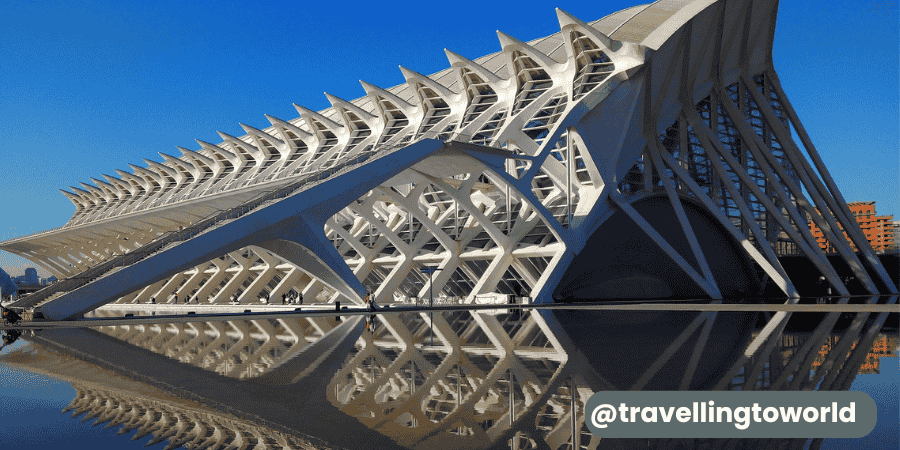
The Marvel Superheroes exhibit offers a fun diversion for those who enjoy comics. The museum’s unique philosophy, “Not touching is prohibited,” encourages visitors to explore its interactive exhibitions on science and technology. The ground floor typically features a temporary exhibition, shops, bathrooms, and a restaurant, but tickets are needed for other exhibitions.
Additionally, the museum offers specialized workshops, for which a separate ticket is necessary.
Umbracle: A Scenic Walk in the City of Arts and Sciences
The Umbracle, completed in 2001 , is a stunning 320-meter-long open structure. This offers visitors a chance to explore a lush garden filled with native plant species that change with the seasonal display. This magnificent structure features 55 fixed arches and 54 floating arches, each reaching the heights of 18 meters. These arches provide a beautiful airy canopy above.
As you stroll through the Walk of the Sculptures, you’ll be surrounded by contemporary works from renowned artists like Yoko Ono and Miquelof Navarre, creating an outdoor gallery that seamlessly blends art with nature. The gardened esplanade and exhibition zone offer breathtaking views of the entire complex, including the buildings, lakes, walkways, and landscaped areas of the City of Arts and Sciences.
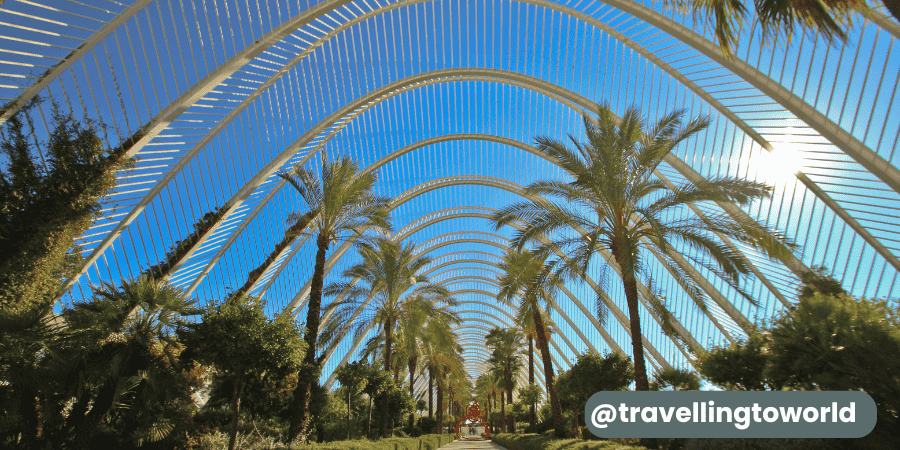
This vantage point, spread across 14,000 square meters, allows visitors to contemplate the Mediterranean vegetation unique to the Region of Valencia and tropical regions. Under the impressive arches, a peaceful sculpture garden with various plants typical of Valencia, including palm trees, enhances the tranquil atmosphere
Oceanogràfic: Explore the Marine World at the City of Arts and Sciences
The Oceanogràfic at the City of Arts and Sciences in Valencia is a must-see attraction, known as Europe’s biggest aquarium. Completed in 2003 and designed by Félix Candela, it stands out with its unique water lily shape. The facility features seven marine environments, each showcasing aspects of the world’s main marine ecosystems. Visitors can explore habitats like the Mediterranean, Wetlands, Temperate Seas, Tropical Seas, and Oceans.
Additionally, the Antarctic, Arctic, Islands, and Red Sea habitats provide a global experience of aquatic life. Home to 45,000 specimens and 500 species, it brings people face-to-face with diverse marine creatures.The dolphinarium offers a daily exhibition where visitors enjoy watching these animals in action.

The Oceanogràfic also includes habitats for wetland bird species, creating a complete view of diverse aquatic and semi-aquatic life. Its well designed architecture blends nature and art, offering a memorable experience for all.
Palau de les Arts: A Cultural Icon in the City of Arts and Sciences
The Palau de les Arts or Queen Sofía Palace of the Arts is a key destination for culture enthusiasts visiting Valencia’s City of Arts and Sciences. Completed in 2005, Designed by the renowned architect Santiago Calatrava, the building’s futuristic shape, featuring sweeping curves and glass foyers, creates a stunning setting for classical music, Flamenco, and more.
Surrounded by 87,000 square meters (936,460 square feet) of landscaped water and greenery, it offers 10,000 square meters (107,639 square feet) of walkable space for visitors to explore, enhancing the tranquil atmosphere with scenic views. The interior of the Palau de les Arts comprises four main sections: the main hall, master hall, auditorium, and Martin y Soler theatre. Each of these spaces is meticulously designed to host a variety of events, from theatre to music performances, all set within an environment that celebrates the performing arts.
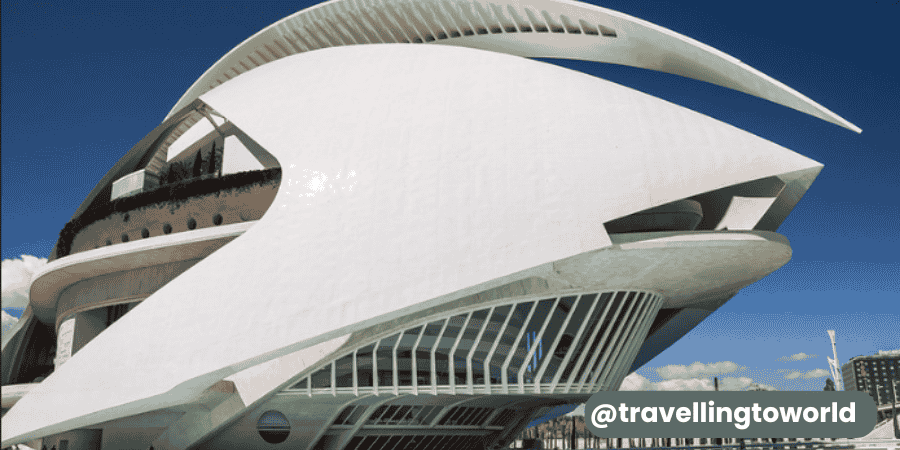
Renowned for its diverse programme from October through November, the venue offers a rich lineup of operas, concerts, zarzuela, and ballet performances. The concert hall and opera house also provide guided tours that can be booked in advance on the website, giving visitors a chance to experience the impressive architecture and cultural atmosphere up close.
Assut de l’Or Bridge: Connecting the City of Arts and Sciences
The L’Assut d’Or Bridge, designed by Santiago Calatrava, is a remarkable structure in Valencia. Completed in 2008, this suspension bridge connects the south side with Minorca Street. Its 125-meter-high pillar, the tallest point in the city, stands out as a remarkable feat of engineering. This white, cable-stayed bridge features a curved pylon with counterweights, and provides a smooth flow of traffic lanes as well as a pedestrian bridge for walkers.Connecting key landmarks like the Science Museum and Ágora, the bridge is both a functional structure and an architectural landmark in the heart of the city.
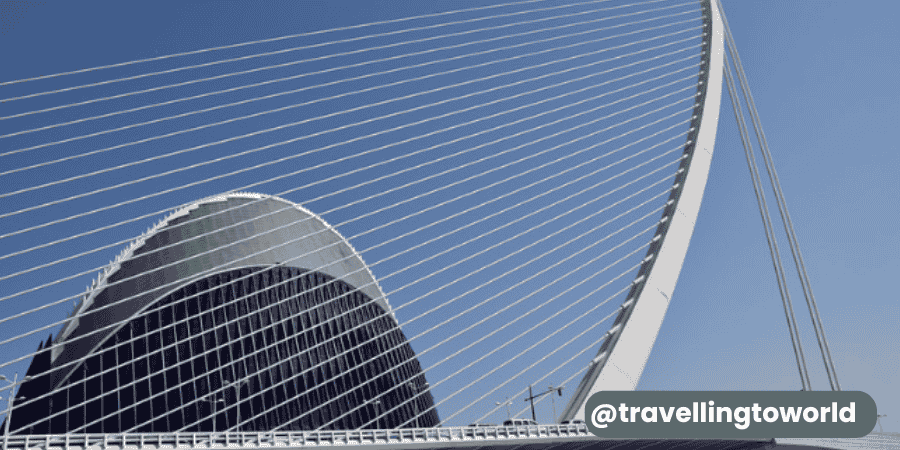
The City of Arts and Sciences is located in the south-east of Valencia, spanning the final sections of the Turia riverbed, between three sections (14th to last) and two streets. The complex starts with the opera house on Avenida del Professor López Piñero and continues along Carrer d’Eduardo Primo Yúfera, ending near the harbor close to the Oceanogràfic.
Ways to Reach the City of Arts and Sciences
Whether you prefer to take public transport or enjoy a scenic walk, getting to the City of Arts and Sciences is easy. Once you’re done exploring this modern marvel, be sure to check out other highlights in Valencia, such as the annual Las Fallas Festival, for an unforgettable cultural experience.
By Metro/Tram:
The closest metro station is Alameda, 1.8 km away, which is a 20-minute walk. Tram lines 10 (Ciutat Arts i Ciències and Oceanogràfic) stop closer to the complex.
By Bus:
Several bus lines, including 15, 24, 25, and 95, stop near the City of Arts and Sciences.
On Foot:
The complex is about a 30-minute walk from the city center. A scenic route through Turia park is popular among locals, taking approximately 40 minutes from Torres de Serranos to the City of Arts.
Final Thoughts
Valencia’s architectural wonders are just the beginning of Spain’s cultural treasures. If you want more stunning views, check out our guide to Las Fallas festival in Valencia. Or, continue your Spanish adventure by visiting Things to Do in Edinburgh, Scotland, a city rich in culture and history. There’s always something new to explore!

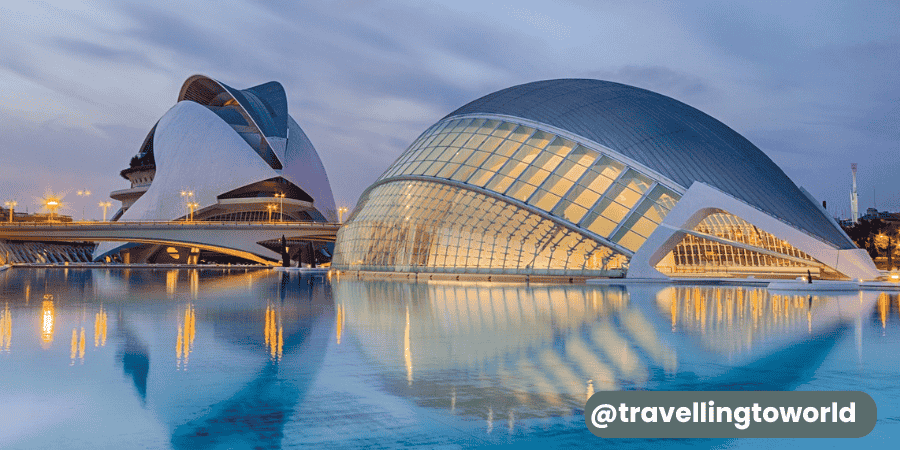
One response
[…] City of Arts and Sciences, Valencia: Where Art Meets Innovation […]